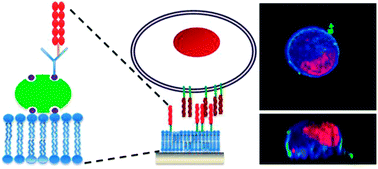The study of polarisation in single cells using model cell membranes†
Abstract
The apicobasal polarisation of epithelial cells within an epithelium is critical for its function as a selective barrier. Microenvironmental parameters, including cell–

Maintenance work is planned for Wednesday 1st May 2024 from 9:00am to 11:00am (BST).
During this time, the performance of our website may be affected - searches may run slowly and some pages may be temporarily unavailable. If this happens, please try refreshing your web browser or try waiting two to three minutes before trying again.
We apologise for any inconvenience this might cause and thank you for your patience.
* Corresponding authors
a
Laboratory for Surface Science and Technology, Department of Materials, ETH Zurich, Zurich, Switzerland
E-mail:
mirren.charnley@mat.ethz.ch
Fax: +41-44-633 10 27
Tel: +41-44-633 62 29
b Institute of Biochemistry, ETH Zurich, Zurich, Switzerland
The apicobasal polarisation of epithelial cells within an epithelium is critical for its function as a selective barrier. Microenvironmental parameters, including cell–

 Please wait while we load your content...
Something went wrong. Try again?
Please wait while we load your content...
Something went wrong. Try again?
 Fetching data from CrossRef.
Fetching data from CrossRef.
This may take some time to load.
Loading related content
